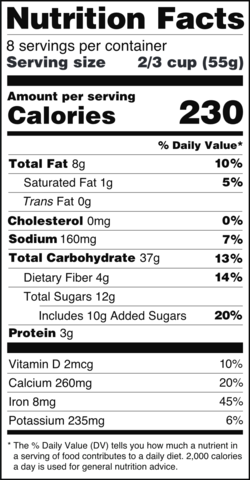Nutrition Facts Labels
Nutrition Facts Labels are governed by the FDA (U.S. Food & Drug Administration) and are commonly found on prepackaged foods. They were updated in 2016 to reflect new scientific information. The refreshed design included increased type size for “Calories,” “Servings Per Container,” and “Serving Size” declaration. “Added Sugars” were added to the label as well an area for “Vitamin D” and “Potassium.” “Calcium” and “Iron” are required to be listed, however “Vitamin A and C” are no longer required, but can be included on a voluntary basis.
It’s important to understand how to interpret the nutrients and values on these labels, so you can ensure you’re obtaining adequate levels in your diet. Labels can help you determine if you’re getting enough fiber (which often lacks in the standard American diet) or eating too much sugar, which can cause uneven energy levels and inflammation.
Here is a simple guide for common terms to help you calculate nutrition information.
Serving Size/# of Servings
- The amount of food that will provide the nutrition information found below it. Depending on serving size, you will need to adjust the rest of the label accordingly. For example, a bag of all-natural tortilla chips may have a serving size of 10 chips, but if you are munching on them while watching a TV show, you may consume upwards of 20-40 chips. A 140 calorie treat can add up to almost 600 calories!
% Daily Value
- These are based on a 2,000 calorie/day diet, so if you require more or less calories, you may need to decrease or increase your serving size. Factors that affect calories needed per day include gender, height, weight, and activity level.
Calories
- Calories are simply defined as energy supplied by food. Keep in mind, however, not all calories are created equal. A 200-calorie snack of an apple with almond butter will keep you satiated much longer than a 200-calorie bag of candy. If you opt for the candy, you may feel hungry more quickly and snack on excess calories throughout the day.
Total Fat, Cholesterol, Sodium, Total Carbohydrates, and Protein
- You’ll find these items listed in grams or milligrams and % of Daily Value. Based on your needs, you can tally up a particular food to see if it provides adequate protein, fat or carbohydrates. This area will also reveal if a food is really high in sodium, which can cause water retention and/or dehydration.
Dietary Fiber, Total Sugars and Added Sugars
- Perhaps the most important parts of the nutrition facts labels. Make sure to pay attention to these numbers! Getting additional fiber in your diet promotes good health. Reducing “total” and “added sugars” helps to stabilize blood sugar and reduce inflammation.
Originally posted 2018-06-27 15:27:34.








